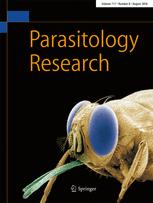Ver ítem
- xmlui.general.dspace_homeCentros Regionales y EEAsCentro Regional Entre RíosEEA ConcordiaArtículos científicosxmlui.ArtifactBrowser.ItemViewer.trail
- Inicio
- Centros Regionales y EEAs
- Centro Regional Entre Ríos
- EEA Concordia
- Artículos científicos
- Ver ítem
Validation of models to estimate the fumigant and larvicidal activity of Eucalyptus essential oils against Aedes aegypti (Diptera: Culicidae)
Resumen
The aim of this work is to validate the pre-existing models that relate the larvicidal and adulticidal activities of the Eucalyptus essential oils on Aedes aegypti. Previous works at our laboratory described that the larvicidal activity of Eucalyptus essential oils can be estimated from the relative concentration of two main components (p-cymene and 1,8-cineole) and that the adulticidal effectiveness can be explained, to a great extent, by the presence of
[ver mas...]
The aim of this work is to validate the pre-existing models that relate the larvicidal and adulticidal activities of the Eucalyptus essential oils on Aedes aegypti. Previous works at our laboratory described that the larvicidal activity of Eucalyptus essential oils can be estimated from the relative concentration of two main components (p-cymene and 1,8-cineole) and that the adulticidal effectiveness can be explained, to a great extent, by the presence of large amounts of the component 1,8-cineole in it. In general, the results show that the higher adulticidal effect of essential oils the lower their larvicidal activity. Fresh leaves was harvested and distilled. Once the essential oil was obtained, the chemical composition was analysed, evaluating the biological activity of 15 species of the genus Eucalyptus (Eucalyptus badjensis Beuzev and Welch, Eucalyptus badjensis × nitens, Eucalyptus benthamii var Benthamii Maiden and Cambage, Eucalyptus benthamii var dorrigoensis Maiden and Cambage, Eucalyptus botryoides Smith, Eucalyptus dalrympleana Maiden, Eucalyptus fastigata Deane and Maiden, Eucalyptus nobilis L.A.S. Johnson and K.D.Hill, Eucalyptus polybractea R. Baker, Eucalyptus radiata ssp radiata Sieber ex Spreng, Eucalyptus resinifera Smith, Eucalyptus robertsonii Blakely, Eucalyptus robusta Smith, Eucalyptus rubida Deane and Maiden, Eucalyptus smithii R. Baker). Essential oils of these plant species were used for the validation of equations from preexistent models, in which observed and estimated values of the biological activity were compared. The regression analysis showed a strong validation of the models, re-stating the trends previously observed. The models were expressed as follows: A, fumigant activity [KT50(min) = 10.65–0.076 × 1,8-cineole (%)](p < 0.01; F, 397; R 2, 0.79); B, larval mortality (%)(40 ppm) = 103.85 + 0.482 × p-cymene (%) − 0.363 × α-pinene (%) − 1.07 × 1,8-cineole (%) (p < 0.01; F, 300; R 2, 0.90). These results confirmed the importance of the mayor components in the biological activity of Eucalyptus essential oils on A. aegypti. However, it is worth mentioning that two or three species differ in the data estimated by the models, and these biological activity results coincide with the presence of minor differential components in the essential oils. According to what was previously mentioned, it can be inferred that the model is able to estimate very closely the biological activity of essential oils of Eucalyptus on A. aegypti.
[Cerrar]

Autor
Lucia, Alejandro;
Juan, Laura Wilma;
Zerba, Eduardo Nicolás;
Harrand, Leonel;
Marco, Martin Alberto;
Masuh, Hector Mario;
Fuente
Parasitology Research 110 (5) : 1675–1686 (May 2012)
Fecha
2012-05
Editorial
Springer
ISSN
0932-0113
1432-1955
1432-1955
Formato
pdf
Tipo de documento
artículo
Palabras Claves
Derechos de acceso
Restringido
 Excepto donde se diga explicitamente, este item se publica bajo la siguiente descripción: Creative Commons Attribution-NonCommercial-ShareAlike 2.5 Unported (CC BY-NC-SA 2.5)
Excepto donde se diga explicitamente, este item se publica bajo la siguiente descripción: Creative Commons Attribution-NonCommercial-ShareAlike 2.5 Unported (CC BY-NC-SA 2.5)

